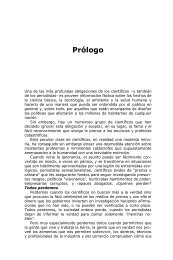Darfur: Blueprint for Genocide - Archipielago Libertad
Darfur: Blueprint for Genocide - Archipielago Libertad
Darfur: Blueprint for Genocide - Archipielago Libertad
You also want an ePaper? Increase the reach of your titles
YUMPU automatically turns print PDFs into web optimized ePapers that Google loves.
tension between the tw o communities. Western <strong>Darfur</strong><br />
was put under military rule. Many educated Massaleit and<br />
Massaleit members of the state council were arrested.<br />
Against this background of state repression, Arab militias<br />
began attacking and burning Massaleit villages with<br />
killings of up to 75 people at a time. Attacks were timed to<br />
coincide with the harvest. The Government claimed that<br />
this was a tribal conflict although there were reports of the<br />
inv olvement of uni<strong>for</strong>med men. 29 Identity badges found on<br />
a number of dead militia showed one to be a colonel in the<br />
Sudanese army and indicated that some members came<br />
from Chad, Liby a and Sy ria. 30<br />
Betw een 15 July 2000 and 28 April 2002 therewere 156<br />
attacks recorded by Fur members of Parliament (National<br />
Assembly). They handed the list that<br />
they compiled to Sudanese President,<br />
Al Bashir. See Appendix F <strong>for</strong> list<br />
referring to dates and locations of<br />
attacks, numbers of people killed and<br />
injured in each attack and number of<br />
properties lost.<br />
Further evidence of organised v iolence<br />
against African villages pre-dating the<br />
rebel attacks in February 2003 can be<br />
found in a document written by the son<br />
of the last Fur Sultan. Be<strong>for</strong>e he died in 2003, he<br />
documented all the African villages that had been<br />
destroyed from 2000. The list exceeds 200 villages. A<br />
translatedversion can be found in Appendix E.<br />
3.2 Genocidal acts in the current<br />
crisis<br />
3.2.1 Killing: targeting civilians<br />
In Nov ember 2004 the number of deaths commonly<br />
quoted in <strong>Darfur</strong> is 70,000. However, this figure only<br />
represents deaths in IDP camps in <strong>Darfur</strong> betw een March<br />
and the beginning of October 2004. 31 To date the accurate<br />
figure <strong>for</strong> deaths in the genocide is unknown, but Eric<br />
Reeves has used a variety of sources and statistical<br />
methods to estimate mortality numbers approaching<br />
29 Johnson, D. (2003). The Root Causes of Sudan’s Civil Wars,<br />
International African Institute, London, p. 141.<br />
30 Sudan Human Rights Organization (2000). “ Ethnic Cleansing of<br />
the <strong>Darfur</strong> Muslims: The Massaleit”, http://www.shrocairo.org/reports/masaleit.htm,<br />
[Accessed 7 October 2004].<br />
31 WHO, (2004). “ Mortality Projections <strong>for</strong> <strong>Darfur</strong>” , 15 October 2004,<br />
http://www.who.int/disasters/repo/14985.pdf [Accessed 13<br />
November 2004].<br />
‘Organised<br />
violence against<br />
African villages<br />
pre-dated rebel<br />
attacks in<br />
February 2003.’<br />
Section 3: Systematic Actions Amounting to <strong>Genocide</strong><br />
300,000. 32 Save the Children now agrees that 200,000 to<br />
300,000 have died since the start of the <strong>Darfur</strong> conflict. 33<br />
Some of these deaths are a direct result of v iolence,<br />
others due to the livingconditions of the displaced.<br />
The Médecins sans Frontières (MSF) station at the Chad-<br />
<strong>Darfur</strong> border town of Adré was expecting many wounded<br />
refugees inChad. But they did not arrive. Many remained<br />
IDPs in <strong>Darfur</strong>. The 200,000 that went to Chad by July<br />
2004 seeped over the long border and gradually<br />
congregated in camps. As the refugee camps began to<br />
swell in Chad in the spring and summer of 2004,<br />
journalists and NGO workers remarked that the refugees<br />
arriv ed without sign of injury. The absence of obvious<br />
wounds, blood and corpses suggested that these were<br />
civilians fleeing a civilwar.<br />
It took closer scrutiny to understand<br />
what was happening. In July 2004 one<br />
of the authors, James Smith, a<br />
physician, found that many refugees in<br />
the Chad camps had evidence of<br />
wounds betw een 3-6 months old,<br />
consistent w ith gunshot injuries. This<br />
included many children. Most refugees<br />
had taken many months to arrive in the<br />
camps in Chad. They had remained<br />
internally displaced, then travelled long distances.<br />
Consequently, by the time they met w estern observers,<br />
victims had either died of their wounds or they had healed.<br />
Many also testified to Aegis how they had witnessed<br />
members of the family being killed. In random groups of<br />
refugees in the camps; over half of the men, women and<br />
children had always seen a family member killed during<br />
attacks on the villages. Most of these had lost multiple<br />
members of their families.<br />
Analysis of more comprehensive interviews carried out <strong>for</strong><br />
the United States State Department report found that 61%<br />
of refugees reported having seen a member of their family<br />
killed and 67% reported seeing a non-family member<br />
killed. 34<br />
In attacks on villages there has often been an emphasis<br />
on the killing of the male population. There have been<br />
instances reported of males being rounded up and<br />
32 Eric Reeves,“ <strong>Darfur</strong> Mortality Update” , 8 October 2004<br />
http://www.sepnet.org/index .php?op=ViewArticle&articleId=334&blog<br />
Id=1 [Accessed 16 November 2004].<br />
33 Save the Children spokesman Paul Hetherington, quoted by<br />
Gethin Chamberlain in The Scotsman, 18 November 2004.<br />
34 United States State Department (2004) Documenting Atrocities in<br />
<strong>Darfur</strong>, Bureau of Democracy, Human Rights, and Labor and the<br />
Bureau of Intelligence and Research, (State Publication 11182).<br />
14




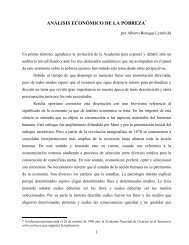
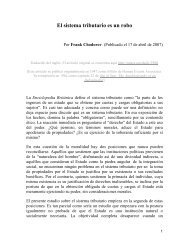
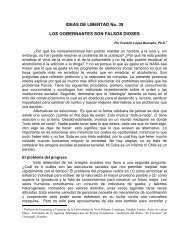
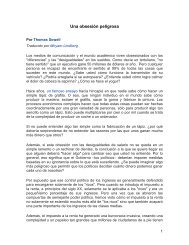
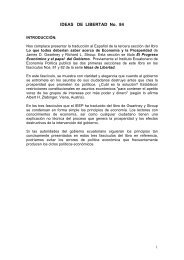



![0091 Stewart - La magia y el misterio del comercio [parte I].pdf](https://img.yumpu.com/16943279/1/169x260/0091-stewart-la-magia-y-el-misterio-del-comercio-parte-ipdf.jpg?quality=85)


